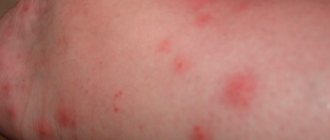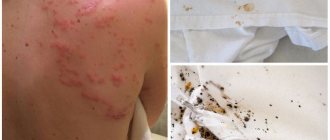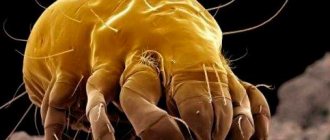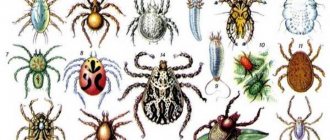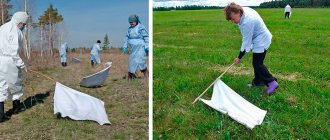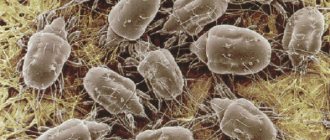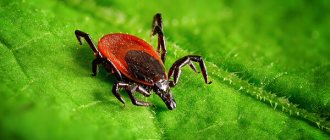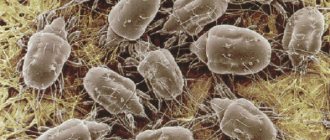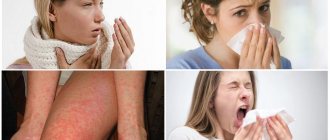Those who have summer cottages located near the forest often have to be a victim of ticks. Small insects, and what harm they bring to humans! After all, they are the carriers of such dangerous diseases as tick-borne encephalitis and tick-borne borreliosis, which sometimes lead to disability.
Few people are happy with such neighbors. Every year we have to reclaim our territory from the invasion of insects, but they appear again and again. And sometimes it is very difficult to cope with them. However, there are simple and effective ways to help get rid of ticks in your area. Then how to protect yourself and your children from tick-borne infections, the carriers of which are ixodid ticks? This is what we're talking about today.
How dangerous are ticks for humans?
Ixodid ticks are carriers of tick-borne encephalitis virus and Lyme disease borrelia (tick-borne borreliosis).
Tick-borne encephalitis
It is severe with the manifestation of symptoms of intoxication (severe headaches and muscle pain, vomiting, weakness, sleep disturbance, fever to high levels). The disease develops on average 7-10 days after the bite. But the incubation period can be extended to 21 days and shortened to 2-3 days. It all depends on the number of viruses that have entered the body, the virulence of the virus itself, the person’s body’s resistance to infection and many other factors.
But encephalitis is especially dangerous due to its complications. And although at present there are almost no deaths, however, after the illness there remain such terrible complications as paralysis and paresis of the limbs, which remain for life and lead to disability.
You can prevent infection by getting vaccinated against tick-borne encephalitis on time. Such vaccinations are given at any clinic or medical center.
Tick-borne borreliosis
This is a systemic disease that affects different organs and systems - skin, nervous system, musculoskeletal system, cardiovascular system, eyes, liver, spleen. The disease develops 2-3 weeks after a tick bite. A characteristic sign of the disease is creeping erythema: a red spot appears at the site of the bite, which increases over time.
The disease is characterized by intoxication and symptoms associated with the affected organ. The disease is characterized by relapses. Unlike tick-borne encephalitis, there are no vaccinations against this infection; a vaccine has not yet been developed.
Folk methods of struggle
If you want to do without chemicals completely, then it is better to use proven folk remedies. Experienced summer residents recommend the following:
- Irrigation of the area with solutions of essential oils. In particular, rosemary and mint. It turns out that the tick does not tolerate these odors. It is enough to add 5-10 drops of oil to water and spray it on garden crops.
- Citrus juice. It also works well as a bloodsucker remedy. Moreover, you can use both fresh juice and aromatic oils of orange, tangerine, and lemon for irrigation.
- Boric acid or soda. These products need to be sprinkled in places where ticks accumulate to get rid of them.
- Infusion of wormwood. Here you need to take 2 kg of chopped grass and pour moderately hot water (10 liters) for two days. After this, the infusion is boiled for half an hour. All that remains is to bring the decoction again with cold water to a volume of 10 liters. The finished product is diluted with clean water in a ratio of 1: 2 and the area is sprayed. Using the same principle, you can prepare infusions of geranium or sage. They also repel ticks.
- Garlic infusion. To prepare it, add two liters of water to four heads of garlic. Infuse the solution for 5 days in a dark and cool place. Before irrigating the area, the product is diluted with water in a 1:1 ratio.
- Cyclamen roots. An infusion is prepared from them according to this recipe - 100 grams of tubers are poured into 1 liter of boiling water. Now cook the roots until they are completely cooked until they soften. The finished product is cooled and strained. The area is sprayed with the decoction.
- You can also plant natural insecticides around the perimeter. These are chamomile, wild rosemary, tansy, bird cherry. They repel the bloodsucker and prevent it from entering the area.
Advice: in order to protect the territory as much as possible from tick invasion, it is advisable to team up with your neighbors and carry out simultaneous treatment of two or more areas. It is advisable to take the family to the dacha no earlier than 4-6 days after baiting the insect.
Interesting: Wasp nest: instructions for getting rid of it
How does infection occur?
One thing needs to be taken into account. The tick does not attach itself immediately. Having attacked a person, it crawls over clothes for some time and looks for a place where it could get on the person’s skin. Once on the skin, the insect also does not immediately attach itself, but looks for the most convenient places for suction. This can be the skin of the armpits, thighs, genitals, on the head, neck, behind the ears, that is, places with the thinnest and most delicate skin.
The person does not feel the moment of suction, since the bite injects an anesthetic substance along with saliva. Sometimes, after sucking blood, the tick disappears on its own. Only sometimes there is soreness and redness in this place.
However, not every tick can be a source of infection. Externally, it is impossible to distinguish an infected insect from a non-infected one. Therefore, if you notice ticks in your area, be sure to take measures to combat them. Especially if your summer cottage is located next to a forest.
Prevention of tick infestation of a summer cottage
To protect yourself from arachnids, follow these recommendations:
- regularly clear your area of last year’s grass and branches, weed out weeds and trim the lawn in a timely manner so that the vegetation does not become tall;
- remove garbage and unnecessary rubbish from the territory;
- make a barrier of sawdust or gravel along the fence (1 meter wide), then ticks will not penetrate from neighbors;
- destroy rodents, they are the most important carriers of insects;
- carefully monitor your pets, treat their fur with special anti-tick preparations;
- plant insecticidal plants (calendula, thyme, chamomile, lavender) in your summer cottage;
- try to ensure that thrushes or starlings live in the area; they feed on parasites; for this, install feeders.
Reader's opinion If ticks appear on your property, then not only you, but also your neighbors should take care of treatment. Otherwise, all efforts will be wasted. Vladimir
The best method of controlling ticks is to take preventive measures. After all, it is better to prevent the appearance of pests than to spend a lot of time, effort and money on their extermination.
How to protect yourself from ticks
There are many ways to protect yourself from ticks when you go to the forest, hike, relax in nature, or work in your summer cottage.
How to protect yourself from ticks in the forest
Ticks wait for their prey on tall grass and bush branches along paths and roads. This means that the task of any person going about his business in the forest is to dress appropriately so that insects do not have a chance to crawl onto your skin.
- Dress appropriately. Put a scarf or mosquito net on your head, tighten the sleeves of your jacket with an elastic band and a tight cuff. Tuck your trousers into boots or shoes;
- Use repellents—means that repel midges, mosquitoes, ticks, and horseflies. A large assortment of these products is available in any store and pharmacy. The ticks “having smelled the chemicals” weaken and fall off on their own without having time to attach themselves;
- Knowing that ticks do not attach immediately, regularly, every hour or two, conduct self- or mutual examinations. Do not crush detected insects under any circumstances: there may be tiny wounds on your fingers through which the virus can enter the blood. This is how you can get infected too. Place the detected tick in a matchbox or in a vial so that you can send it to the laboratory for examination. Or just burn it.
How to protect yourself from ticks in nature
When going on vacation in nature, do not forget about these simple rules.
- Choose a place to rest away from dead wood and tall grass;
- Choose a place to rest on a large sunny lawn, where there is no tall grass and it is well blown by the wind;
- Don't forget about repellents.
As a rule, dogs are taken with them into nature. They are unlikely to sit next to you. After running through the forest, they will definitely bring you ticks on their fur. Treat your dog's fur with repellent. And when returning home, carefully examine the dog's fur.
When picking a bouquet of wildflowers and birch branches for a broom to take a steam bath in the bathhouse, be careful. It is with flowers and branches that ticks are brought into the apartment. Then they wonder: how did a small child, who had never been in the forest, get bitten by a tick? Therefore, before you bring flowers or branches home, keep them outside in the sun for a while. And it’s best not to bring such plants into the apartment at all.
How to deal with ticks in the countryside
When the forest is next to a summer cottage or vegetable garden, it is very convenient. There is no need to travel far for berries and mushrooms. However, there is a danger of tick bites. Insect attacks can be prevented by following these tips.
- Before the start of the summer season, first clear the area of remaining old branches and dried grass;
- In autumn, remove leaves under trees and shrubs; ticks and other pests may remain there for the winter;
- Mow the grass more often and remove weeds from the beds, especially since all this can be used for compost, hot grass, or for mulching;
- The most reliable and effective way to protect yourself from ticks on your property is to treat the nearby forest area and your property with special preparations—repellents. Such treatments are carried out by a special sanitary service. Or, after consultation with specialists, the treatment is carried out by the owners of the dachas themselves.
How to protect yourself from ticks - folk remedies
Any blood-sucking insects do not like strong odors, for example, the smell of cinnamon, cloves, camphor, Chinese star balm and even triple cologne.
- You can make your own oil from cinnamon and cloves. For this purpose, add 1 teaspoon of ground cinnamon or 10 cloves to 100 ml of warm vegetable oil. Let it brew in a warm place for several days. Before going out into the forest, going on a hike, or working in the country, lubricate exposed parts of the body with this oil.
- In 1 liter of water put 1 tbsp. l. ground cinnamon or cloves, boil a piece of gauze in this solution. Without rinsing, wring out the gauze and dry. Wear gauze like a scarf before going into the forest or working in the garden.
- While relaxing in nature, place around sharp-smelling plants (wormwood, tansy, lilac, geranium, lavender), branches of rowan, and flowering bird cherry. They will not only repel ticks, but also mosquitoes.
- Use essential oils. Dissolve ½ teaspoon of clove, fir, eucalyptus, or tea tree oil in half a glass of warm water. Lubricate exposed areas of the body with the mixture, and spray the remainder onto clothing. Apple cider vinegar, onion and garlic juice have similar properties.
- When you see an anthill in the forest, take off your outer clothing and place it on the anthill for 10-15 minutes. Afterwards, shake off the ants thoroughly. You can buy formic alcohol at the pharmacy.
How thoroughly should the vegetation be irrigated during processing?
Almost all instructions for acaricidal agents recommend fluid consumption at the rate of 1 liter of working solution/100 sq.m. (one hundred square meters). For a household consumer, such a calculation is ineffective. The fact is that the instructions are aimed at professionals who use either motorized sprayers or ULV generators. In them, the liquid is supplied in small droplets and 1 liter per hundred square meters is quite enough. When treated with a regular garden sprayer, be it pump or hydraulic (and this is what you have to use in everyday life), the liquid is sprayed in large drops and the emulsion is consumed faster. One liter of solution is not enough to evenly treat 1 hundred square meters. The actual consumption is from 3 to 5 liters per 100 sq.m. How, then, can you increase processing efficiency and not spend too much?
Maintain uniformity when applying the product (50 ml/sq.m.). At the same time, make sure that the liquid does not spill, and the applied emulsion does not flow from the leaves into the soil, taking the drug with it. Small, uniform droplets provide the best coverage of the surface being treated, so adjust the nozzle pattern accordingly. Otherwise, the treatment may turn out to be of poor quality and uneconomical, and the product may be wasted.
If the grass is thick (higher than 15-20 cm), or there is a high number of ticks in the area, the amount of treatment solution should be doubled.
However, the consumption of the product is regulated not only by the area and characteristics of the site. For example, when treating against ticks of the genus Dermacentor or Haemaphysalis, it is necessary to increase the concentration of the product in the solution according to the instructions.
Professional anti-tick treatment requires compliance with many practical nuances. If you have questions that you did not find answers to in this article, read about them in the article “Questions about processing a summer cottage: answers from experts.”
How to remove a stuck tick
First of all, don't panic! Secondly, try to remove the bloodsucker from the skin. Some people advise lubricating the back of the tick with oil, but this is useless and will not help. Use other methods.
- When removing a tick at home, find tweezers, grab the back of the tick with it and, gently rocking the tick from side to side, carefully remove it from the skin.
- Take an ordinary thread and tie it in a knot around the insect’s proboscis. Move the ends of the thread apart and, pulling the thread alternately in one direction and the other, carefully remove the tick.
- If the proboscis breaks, remove it like an ordinary splinter.
- The tick can be removed using a syringe, the cannula of which is first cut off. The cut end of the syringe (the piston is in the lower position) is placed towards the insect. By lifting the piston up, a vacuum is created in the cavity of the syringe, and the mite is removed. But as practice shows, it is not always possible to extract an insect this way.
- If you are unable to remove the tick yourself, be sure to contact the nearest medical facility, they will help you remove it.
Effect of poison
Treating the area against ticks
Treating the area against ticks must be carried out according to certain rules. Otherwise, it will cause harm to the environment, animal health, and human health. All chemical preparations for spraying the lawn, garden, yard, and meadow are based on a broad-spectrum insecticide. The active components are classified as medium or low toxic substances and do not cause harm under certain conditions.
Acaricidal treatment against ticks cannot be narrowly targeted. Almost all insects that find themselves within the radius of action of the poison die from the action of the poison. Spraying the area is safe for animals if they do not run on the poisoned grass or climb treated bushes for 3 days. Otherwise, an allergic reaction to the skin, increased salivation, lacrimation, loss of appetite, and vomiting may occur.
The product used to treat an area against ticks penetrates the ticks' body through contact. Causes disruption of the functioning of the nervous system, blocks the transmission of impulses. This leads to muscle paralysis and quick death. Tick poison is effective for a maximum of 3 days, then the toxicity gradually decreases, but remains sufficient to bait bloodsuckers for 1-3 months.
Important!
Anti-mite treatment should not be carried out in the garden during the fruit ripening season. If spraying has occurred, the crop should be harvested no earlier than after 21 days.
When poisoning ticks, you need to wear a special suit, a respirator, rubber gloves, and goggles. When poison gets on the skin, an allergic reaction appears in the form of rashes, itching, redness, and in the respiratory tract - intoxication of varying degrees of severity. You may experience dizziness, nausea, headache, chills, vomiting, diarrhea, rapid heartbeat, decreased blood pressure, and other consequences of improper handling of the poison when trying to exterminate parasites.
Bitten by a tick - what to do?
After removing the attached tick, be sure to treat the wound with any alcohol-containing product (iodine, brilliant green, alcohol wipes, vodka). Remember that the tick should never be crushed. Through microcracks in the skin you can become infected with tick-borne infections.
By the way, you can also become infected with tick-borne encephalitis by consuming unboiled goat milk.
Do not throw away the extracted insect, but put it in a small, tightly closed bottle, and take it to a virology laboratory in your city or town for examination to determine if it is infected with viruses. It is very important.
Victims of a bite must undergo a preventive course of treatment. To prevent tick-borne encephalitis, iodantipyrine is used, and tick-borne borreliosis is amoxicillin. The medicine is taken according to the regimen described in the instructions for use. From my experience, no one who took medications for preventive purposes suffered from tick-borne infections, even if the ticks tested positive.
And be sure to monitor your well-being for 21 days after the bite. The appearance of fever, headaches and muscle pain, weakness, nausea, vomiting should alert you. In this case, you should immediately consult a doctor.
Rules for dealing with ticks in the country
In order not to harm pets, birds and yourself, you need to follow all the nuances when exterminating pests. Especially if chemicals are used:
- Clear the area of unnecessary debris, overgrowth and other debris before processing.
- Under no circumstances exceed the dosage specified in the instructions. This will not bring better results, but will only harm the soil and vegetation.
- The weather on the day of treatment should be calm and dry.
- There should be no rain three days before and after the procedure.
- It is prohibited to carry out treatment earlier than 40 days before harvest.
- Chemicals spilled onto garden crops must be washed off by watering or rainfall. Otherwise, intoxication will occur.
If you still have a choice between treating the area yourself or contacting a specialized company, then the second option would be better. Of course, it will be somewhat more expensive, but this way you won’t have to waste time and effort on spraying. Select your arachnid extermination company carefully. Its employees must be professionals in their field. Therefore, you need to rely on reviews on the Internet or ask friends who have encountered this problem.
What to do if a tick bites a child
If a child is bitten by a tick, it is necessary to carry out the same steps as for adults. Make sure to submit the tick for examination.
Monitor your child's well-being for the first 3 weeks after suction. Any deviation in the child’s health should be alarming; in such cases, the child is immediately shown to a doctor.
In addition, for preventive purposes, children are given free anti-tick immunoglobulin at a medical institution at the rate of 0.1 ml per 1 kg of child weight. The introduction of immunoglobulin provides protection for the first time, since ready-made antibodies are introduced. In the future, if there is a threat of ticks being sucked on again, it is better to undergo a course of preventive vaccinations. Vaccinations in endemic areas are carried out from the age of three.
Do dogs get tick-borne infections?
Unfortunately, they get sick. Running through the forest, dogs easily pick up ticks on their fur, and after an hour or an hour and a half, the tick can become embedded. The incubation period in dogs, just like in humans, depends on the virulence of the virus, the dog’s immunity, etc.
Symptoms of the disease develop depending on the severity of the disease. In severe cases, symptoms develop within 12-24 hours, in mild cases - after a few days. The dog experiences fever, lethargy, apathy, and complete refusal to eat. Symptoms that should alert owners are a wobbly gait, weakness in the front legs, even loss of balance. A terrible sign is when the urine turns brown, vomiting, and frequent stools interspersed with blood appear. Do not tempt fate; if such signs are present, the dog should be taken to the veterinarian as soon as possible.
How to protect dogs from ticks
It is best to predict tick bites in dogs in advance. Therefore, take preventive measures in a timely manner.
- During the period of greatest tick activity, the animal needs to wear an anti-tick collar;
- Get vaccinated to develop immunity against tick-borne infections;
- Treat the animal with repellents;
- After each walk in the forest, carefully inspect the animal’s fur in order to remove insects in time and destroy them.
As folk remedies that are safe for the animal, it is good to use drops of essential oils that are applied to the withers. And washing with tar soap will not only help repel ticks and fleas, but will also heal wounds and relieve irritation and itching.
Chemicals to the rescue
The most reliable and radical remedy against ticks is modern aggressive chemical compounds. These include the following:
- Envidor;
- Sunmite;
- Bi-58;
- Thiovit Jet;
- Ram;
- Digital;
- Dobrokhim.
The listed drugs almost instantly kill not only adults, but also their larvae. But when working with chemicals, it is important to follow these rules:
- Processing is carried out only in protective clothing (long-sleeved shirt, trousers, headscarf, protective mask and gloves);
- Do not use food containers for diluting the composition;
- It is forbidden to pollinate the area on a windy day;
- Spraying is carried out in the morning after the dew has disappeared or in the evening;
- During the flowering period of plants, ticks cannot be baited with chemicals;
- For two to four days after spraying, you need to protect pets and children from walking around the area. It is not advisable to release bees either;
- When processing, it is important to ensure that chemicals do not get into the well, well, or other source of water on the site;
- It is recommended to wait 20-45 days after irrigation before harvesting;
- You cannot spray the land more than twice a season, otherwise the plants will burn;
- Irrigation with chemicals is best done in May-April and October-November.
- It is strictly prohibited to increase the dosage of the drug per unit area.
To make the event more effective, you must first remove all construction and plant debris from the site. Otherwise, the tick will escape there during the treatment period. The result of spraying will be zero.
Important: for the purpose of prevention, the use of chemical agents against ticks is strictly prohibited.
